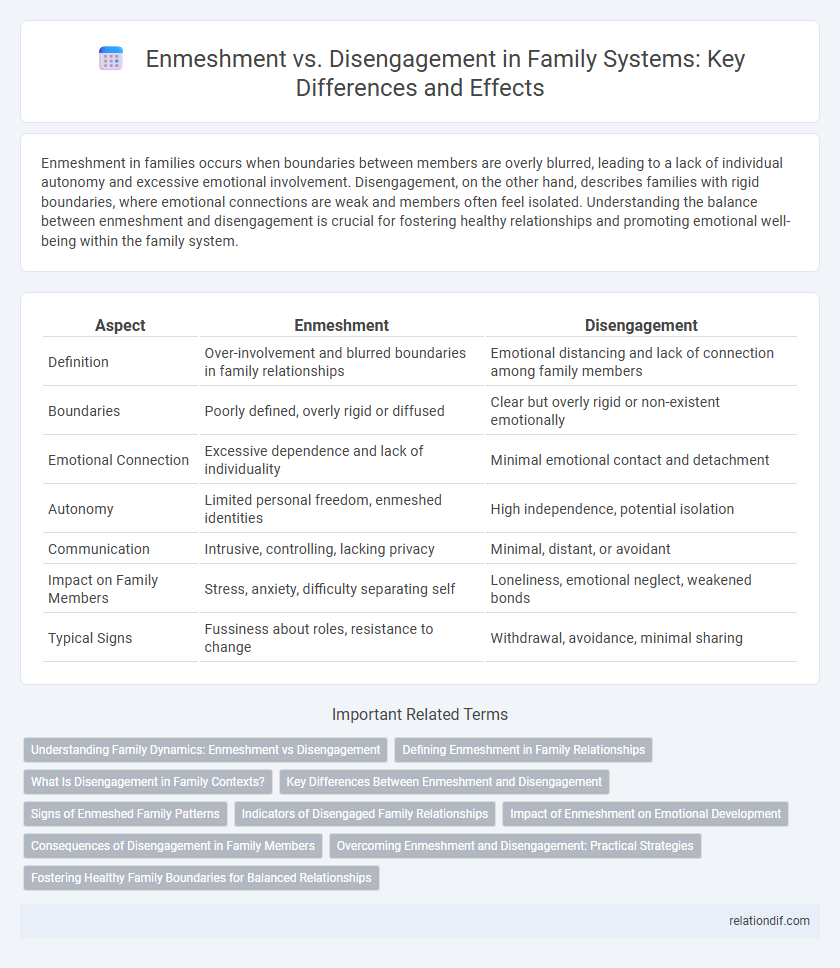Enmeshment in families occurs when boundaries between members are overly blurred, leading to a lack of individual autonomy and excessive emotional involvement. Disengagement, on the other hand, describes families with rigid boundaries, where emotional connections are weak and members often feel isolated. Understanding the balance between enmeshment and disengagement is crucial for fostering healthy relationships and promoting emotional well-being within the family system.
Table of Comparison
| Aspect | Enmeshment | Disengagement |
|---|---|---|
| Definition | Over-involvement and blurred boundaries in family relationships | Emotional distancing and lack of connection among family members |
| Boundaries | Poorly defined, overly rigid or diffused | Clear but overly rigid or non-existent emotionally |
| Emotional Connection | Excessive dependence and lack of individuality | Minimal emotional contact and detachment |
| Autonomy | Limited personal freedom, enmeshed identities | High independence, potential isolation |
| Communication | Intrusive, controlling, lacking privacy | Minimal, distant, or avoidant |
| Impact on Family Members | Stress, anxiety, difficulty separating self | Loneliness, emotional neglect, weakened bonds |
| Typical Signs | Fussiness about roles, resistance to change | Withdrawal, avoidance, minimal sharing |
Understanding Family Dynamics: Enmeshment vs Disengagement
Enmeshment in family dynamics occurs when boundaries are overly blurred, leading to excessive emotional involvement and a lack of individual autonomy, while disengagement is characterized by rigid boundaries and emotional distance that hinder connection and support. Understanding these patterns is crucial for fostering healthy relationships, as enmeshed families often struggle with codependency, and disengaged families face challenges in emotional communication and intimacy. Therapeutic interventions targeting boundary regulation can promote balance, helping family members develop autonomy while maintaining supportive connections.
Defining Enmeshment in Family Relationships
Enmeshment in family relationships occurs when personal boundaries are blurred, leading to an excessive emotional closeness that undermines individual autonomy. This dynamic often results in members feeling overly responsible for each other's emotions and decisions, causing dependency and limited personal growth. Understanding enmeshment is crucial for fostering healthy boundaries and promoting emotional independence within families.
What Is Disengagement in Family Contexts?
Disengagement in family contexts refers to emotional distance and lack of communication among family members, resulting in reduced support and connection. This dynamic often leads to feelings of isolation and weakened family bonds, contrasting sharply with healthy emotional involvement. Understanding disengagement is crucial for addressing issues of family dysfunction and fostering more supportive relationships.
Key Differences Between Enmeshment and Disengagement
Enmeshment involves overly blurred boundaries where family members are overly involved in each other's lives, leading to a loss of autonomy and personal identity. Disengagement is characterized by rigid boundaries and emotional distance, resulting in a lack of support and connection among family members. Key differences include the level of emotional involvement, boundary clarity, and the impact on individual independence within the family system.
Signs of Enmeshed Family Patterns
Signs of enmeshed family patterns include blurred boundaries where individual autonomy is limited and family members overly depend on each other emotionally. Excessive involvement in personal matters and a lack of privacy often result in members struggling to develop independent identities. This dynamic leads to difficulties in setting healthy boundaries and increased emotional fusion within the family unit.
Indicators of Disengaged Family Relationships
Disengaged family relationships exhibit clear indicators such as emotional distance, minimal communication, and lack of support during important life events. Family members often function independently with limited involvement or interest in each other's lives, leading to feelings of isolation and neglect. These patterns contribute to weakened family bonds and reduced opportunities for emotional connection and mutual support.
Impact of Enmeshment on Emotional Development
Enmeshment in family dynamics blurs boundaries, leading to impaired emotional development as individuals struggle to establish autonomy and self-identity. This over-involvement often results in heightened anxiety, dependence, and difficulty regulating emotions. Long-term effects can include challenges in forming healthy relationships and increased vulnerability to mental health disorders.
Consequences of Disengagement in Family Members
Disengagement in family relationships leads to emotional distance, resulting in feelings of isolation and abandonment among members. This lack of connection often contributes to poor communication, decreased support, and increased risk of mental health issues such as depression and anxiety. Over time, persistent disengagement can weaken family bonds and hinder the development of trust and emotional security.
Overcoming Enmeshment and Disengagement: Practical Strategies
Overcoming enmeshment involves setting healthy boundaries and fostering individual autonomy within family relationships to promote emotional independence. Addressing disengagement requires consistent communication and intentional efforts to rebuild trust and emotional connection among family members. Therapeutic approaches such as family counseling or cognitive-behavioral techniques can effectively facilitate balance between closeness and personal space.
Fostering Healthy Family Boundaries for Balanced Relationships
Fostering healthy family boundaries involves recognizing and addressing enmeshment, where members are overly involved in each other's lives, and disengagement, characterized by emotional distance and lack of communication. Balanced relationships emerge when families establish clear, flexible boundaries that promote autonomy and emotional support simultaneously. This dynamic encourages trust, respect, and individual growth while maintaining a strong familial connection.
enmeshment vs disengagement Infographic

 relationdif.com
relationdif.com